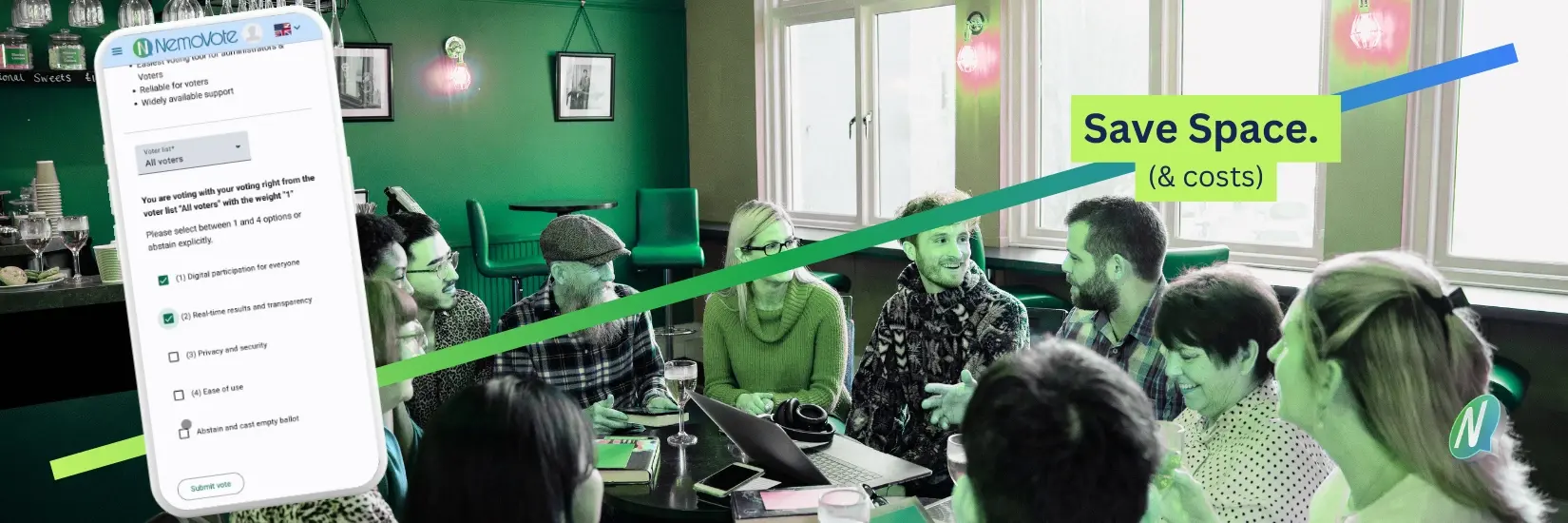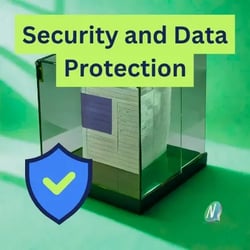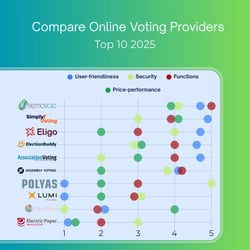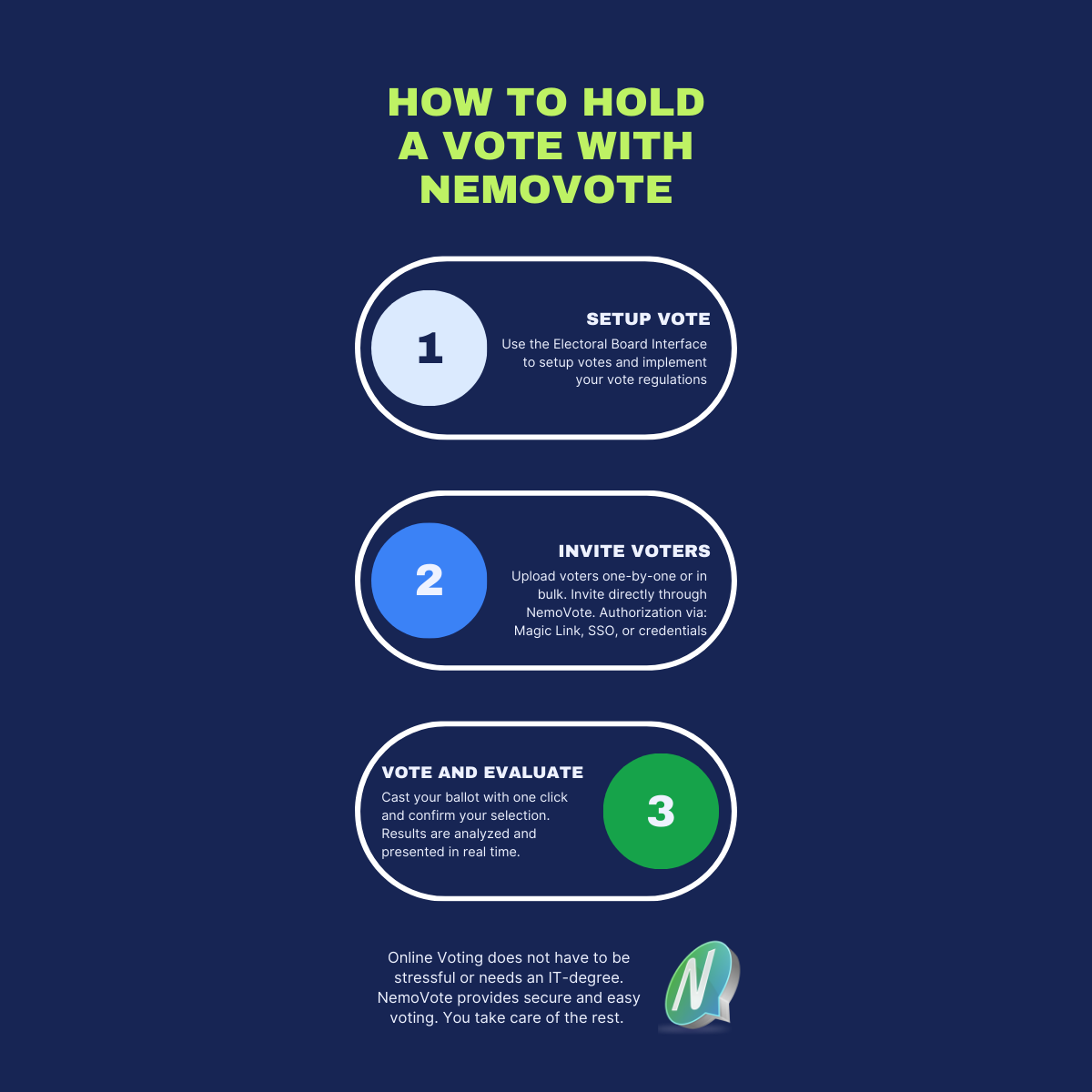Secure Online Voting Made Simple – Insights, Guides & Best Practices
The comprehensive guide to digital voting in your organization
Digital transformation does not stop at democratic processes. Online elections have evolved from a vision of the future to a proven reality that is already being used successfully by thousands of organizations. Whether it's an association election, works council election, or committee vote at your AGM or EGM , digital voting procedures offer compelling advantages while maintaining the highest security standards.
Security and data protection in online elections
Trust through the highest security standards and full GDPR compliance.
Instructions and experience with NemoVote
Practical step-by-step instructions for successful online elections.
Group-specific content & online voting needs
Customized solutions for different types of organizations and industries.
Technological innovation in online elections
Future technologies such as AI and important developments for modern electoral systems.
Best Online Voting Software 2025
Trust through the highest security standards and full GDPR compliance.
Chapters
- 6 advantages of online elections over analogue voting
- Voting Challenges and how to overcome them
- Security: Check for this, when choosing an online voting provider
- User-Friendliness: Votings Systems need to be easy. What to look out for
- Cost Saving: Why you save so much money voting online
- Use Cases of Online Voting by User Group
- Getting Started with your first online election
The advantages of online elections at a glance

We discuss this in detail in our article: Five reasons for online voting
-
Significant cost savings
No printing costs, no shipping, no room rentals – online elections reduce election costs by up to 80%.
-
Higher voter turnout
Online elections allow voting without having to travel, which is particularly advantageous for hybrid, supraregional, or even international organizations.
-
Fast results for transparent and traceable elections
Automatic counting delivers accurate election results in real time, without days of manual evaluation.
-
Security and data protection
Online elections offered by some providers are secure, GDPR-compliant, and can be archived more reliably.
-
Accessible and flexible
Digital tools can be adapted to different types of elections (e.g., in-person, hybrid, online). Voters can vote in multiple languages and in an accessible manner.
-
🌱 Bonus: Online voting is environmentally friendly!
Completely paperless implementation conserves resources and significantly reduces CO2 emissions.

What you need to know before introducing online voting: Conducting elections online: challenges and legal situation
Online elections offer time and cost advantages, but require security, data protection, and legal compliance to ensure transparency and acceptance. Professional election software can address these issues by specifically mitigating technical, organizational, and legal hurdles:
Legal compliance & GDPR: Systems from the EU comply with data protection regulations, guarantee secret or anonymous voting and transparent evaluation; data is stored securely on EU servers.
Secure implementation: Software creates digital voter registers, generates individual access data and protects votes using modern encryption.
Automated evaluation: Votes are counted in real time, errors are avoided, and a legally secure result is delivered immediately.
Increase participation: Location-independent voting lowers barriers, especially in hybrid and international elections.
Transparency: Audit logs and audit trails enable traceability and documentation of the election process at any time.
Security aspects: Trust through proven standards

Security is the foundation of every online election. Professional election software meets the same strict standards as banks or government agencies, and in some cases even exceeds them.
GDPR compliance and data protection
Minimal data collection: Only absolutely necessary personal data is collected, which is automatically deleted after the election.
Transparent communication: Voters receive clear information about data processing and their rights.
Technical security measures: Modern AES-256 encryption, TLS-secured data transmission (HTTPS), and strict separation of voter and vote data ensure anonymity and protection against manipulation, as well as End-to-End Verifiability and cryptography, depending on the required security requirements.
Secure authentication: Use of two-factor authentication (2FA) methods such as single sign-on (SSO) and magic links for reliable user identification.
EU hosting: Data is stored and processed exclusively on servers within the EU for maximum data protection.
Legal protection: Provision of data processing agreements (DPAs) and comprehensive data protection documentation to ensure compliance.
Encryption and technical security
Cryptographic methods: Proven encryption mechanisms protect both data transmission and voice storage.
Authentication: Multi-level procedures ensure that only eligible voters can vote without compromising voting secrecy.
Integrity: Digital signatures and hash functions
| Myth 😕 | Fact ✅ |
|---|---|
| “Online elections can easily be hacked and the results manipulated.” |
Professional systems use encryption mechanisms. Voting secrecy is ensured by separating voter data and votes cast. Unlike analog voting, manipulation is virtually impossible thanks to digital signatures (each person can only vote once) and tamper-proof protocols. |
| “You can't be sure who's voting. Votes can be bought.” |
Secure authentication (e.g., through personal access codes, two-factor authentication) ensures the identity of voters. The risk of vote influencing is theoretically lower in secret voting in a voting booth (ballot box voting), but is more prevalent in postal voting. |
|
“The anonymity of my vote is not guaranteed. The provider can see what I voted for.” |
Voting secrecy is paramount. A digital “ballot box principle” anonymizes the vote, completely separating the voter from their vote before it is counted. Personal data is irrevocably deleted after the election. This is contractually (DPA) and technically guaranteed. |
User-friendliness and accessibility in online elections
A secure online election must also be easy to use. The best technical security measures are useless if voters are overwhelmed or participation is too complicated.
Intuitive operation for all age groups
-
Self-explanatory interfaces
Clear navigation and understandable labels enable even those who are less tech-savvy to participate without any problems. Customers repeatedly praise the logical flow of NemoVote—and by that they mean the intuitive user experience.
-
Responsive design
Optimal display on all devices – from desktop computers to smartphones.
-
Multilingual support
International and diverse organizations can conduct elections in different languages. This ensures that every voter can cast their ballot without barriers.
-
Support functions
Integrated instructions, knowledge databases, and support options provide assistance with questions during voting.
Accessibility according to WCAG standards

TL;DR: An online voting app must comply with WCAG 2.1 AA and EAA standards.
Screen reader compatibility: Full support for users with visual impairments through semantically correct HTML structure.
Keyboard navigation: Complete usability without a mouse for people with motor impairments.
High-contrast display: Optimized color contrasts and scalable font sizes improve readability.
Simple language: Easy-to-understand wording without technical jargon makes it easier for everyone to participate.
Cost- and resource-saving elections
Online elections offer significant economic advantages over traditional paper elections. The investment in digital election software often pays for itself after the first use.

Direct cost savings
Elimination of printing costs: No more ballots, election notifications, or informational materials are necessary. The associated savings in effort are particularly beneficial for organizers and moderators.
Elimination of shipping costs: Postage and logistics costs are completely eliminated.
Reduced personnel costs: Automatic processes significantly reduce manual effort.
No room costs: Polling stations, technology, and catering become superfluous.
Indirect efficiency gains
Time savings: Immediate results without days of manual counting.
Higher data quality: Automatic plausibility checks prevent invalid votes.
Better documentation: Complete digital logging of all voting processes.
Scalability: Same system for 50 or 50,000 participants without additional effort.
Return on investment (ROI)
A professional online election typically costs between $2 and $8 per voter—with NemoVote, each voter costs an average of approximately $1. This is significantly less than comparable paper elections or other voting providers. The costs are usually recouped after the first election.
Use cases from various organizations
Online elections have proven themselves in a wide variety of areas. The diversity of successful implementations demonstrates the broad spectrum of applications for digital voting procedures.
Jump directly to your organization
- Associations & Clubs
- Political Parties
- Trade Unions
- Work Councils
- Shareholder Meetings
- Homeowner Associations (HoA)
- Schools and Universities
- Churches & religious groups
- Event Planners and Organisers
Association elections and club voting: Making decisions securely and efficiently
NGOs often face the challenge of making important decisions with members scattered across different geographical locations. Digital voting offers flexibility and transparency in this regard—both for annual general meetings (AGM) and extraordinary meetings (EGM).
Use cases from our article Why Clubs & NGOs Can’t Miss Digital Voting:
Sports clubs voting: Board elections with several hundred members spread across different regions.
Professional associations: Collective bargaining strike elections, delegate elections, and votes on statutes with a high degree of legal certainty.
International organizations: Multilingual elections with participants from different time zones.
Forum Train Europe FTE gives us some examples of how they conduct their digital elections with NemoVote.
Political parties vote online: Clear and transparent processes
Political parties often have to make decisions that are supported by their members. Digital voting makes it possible to ensure efficient and legally compliant processes at both general meetings and extraordinary meetings.
Federal associations: Member vote, federal executive committee election (election of individuals)
State associations: Drawing up lists for state elections, passing resolutions on amendments to the statutes
District associations: Election of the district executive committee, vote on local election programs
Online union elections: Legally compliant ballots
Trade unions need quick, secure, and transparent decisions during collective bargaining or labor disputes. Digital voting makes the entire process more efficient and involves members regardless of their location.
Ballot Vote: Decisions on whether to initiate or continue a collective bargaining strike.
Collective bargaining strike elections: Voting on whether to accept or reject negotiation results.
Delegate elections: Election of collective bargaining committee members with a high degree of legal certainty.
Bylaw votes: Deciding on changes to union bylaws or regulations.
Related article: UFO: How digital voting supports trade unions
Digital works council elections: Efficient decision-making in meetings
In works council meetings, it is often necessary to conduct votes quickly and in a legally compliant manner. Digital works council elections are already legally permitted and successfully in use at Societas Europaea (SE) companies, i.e. European public limited companies and US organizations.
Works council elections: Election of works council members in accordance with the Works Constitution Act (BetrVG)
Election of substitute members: Filling vacant works council seats
Voting in the committee: Resolutions on works agreements or internal regulations
Companies and virtual shareholder meetings: Supported on-site voting
Corporations: Cross-location committee elections with thousands of eligible voters.
Cooperatives: Supervisory board elections and general meeting resolutions.
Shareholder Meetings Vote: Often require votes with clear majorities, such as for the discharge or election of board members. Digital voting is commonly used on-site, but since the pandemic most countries including the USA, United Kingdom, Canada, Australia, France, Spain and Germany also allow them to take place virtually.
Homeowners' Associations (HOAs): Democratic Decision-Making Made Easy
Owners' meetings are often lengthy. This is one of the reasons why owners benefit from digital voting. HOAs can involve members with different schedules and locations, significantly accelerating the decision-making process.
Election of Management: Appointment or dismissal of the property manager
Resolution Vote: Voting on maintenance measures, renovations, or modernizations
Financial Plan & Annual Financial Statements: Approval of the financial plan and annual financial statements
School and University Elections: Promoting Democratic Processes
Educational institutions such as schools, colleges, and universities can promote transparency and participation through digital voting. Academic councils, student organizations, and parent representatives in particular benefit from flexible solutions.
School Voting: Election of the school board and board of trustees, election of the parent advisory council or student council
University Voting: Election of the Senate or Faculty Council, election of the AStA/Student Parliament, election of the university administration or rectorate
Church Elections and Religious Groups: Modernizing Community Decision-Making
Churches and religious organizations can use digital voting to organize member decisions efficiently and transparently – regardless of the location or size of the congregation.
Election of Community Boards: Democratic processes even in large congregations.
Decisions on Events: Votes on programs or initiatives.
Event Organizers: Real-Time Voting
Events thrive on interactivity, and digital voting can help increase participation. They're ideal for surveys or decisions during the event.
Award Show – Audience Voting: Guests vote for their favorite nominees, creating interactive and engaging award experiences
Award Show – Jury Voting: Expert panels cast secure votes in defined categories, with winners revealed instantly through live results.
Feedback: Quick evaluation of opinions or surveys.
We've described how online events can run more smoothly with digital voting in this article: Mastering Online Events: How to Handle Elections and Voting
First Steps to Online Voting
Conducting an online election is easier than many expect. With proper preparation and an experienced partner, you can conduct your first digital vote in just a few weeks.
Free Consultation and Demo
Get a free consultation and test the capabilities of professional voting software. Our experts will support you and your organization:
- Requirements analysis: Which solution is right for your organization? How can your bylaws be best implemented?
- Legal Clarification: All compliance issues are clarified, with security and data protection always being our top priority.
- Technical Integration: Connection to Existing Systems
- Training and Support: Comprehensive support before, during, and after the election
Deepen your Online Voting Knowledge
Learn more about the various aspects of online voting in our specialized advice sections:
🔒 Security & Data Protection
Trust is the foundation of every democratic election. Learn all about technical security measures, GDPR compliance, and proven standards for tamper-proof online voting.
► To Security & Data Protection
📋 Guides & Best Practices
From initial planning to successful implementation. Practical step-by-step instructions, proven checklists, and tips for avoiding common mistakes.
🎯 Target Group-Specific Content
Every organization has its own requirements. Tailor-made solutions for non-profit organizations, companies, youth organizations, and more.
► To Industry specific voting solutions
🚀 Technology & Innovation
Look into the future of digital elections. AI-supported election management, blockchain technology, and upcoming innovations in e-voting.
► Technology & Innovation
Secure Online Voting and Live Elections
Professional, secure and digital elections by NemoVote.










